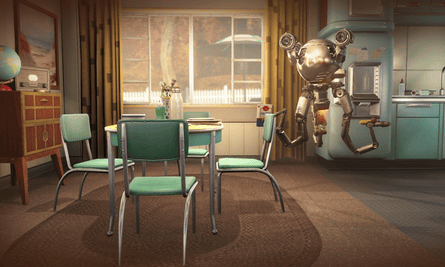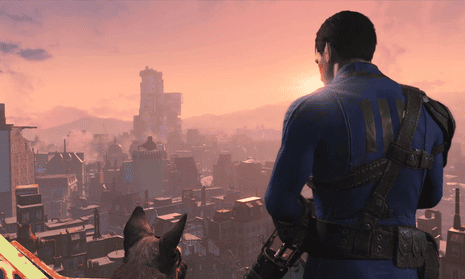Todd Howard says he never stops thinking about the games he makes. When one Elder Scrolls or Fallout project ends, he’s already planning the next. As VP of development at Bethesda Games Studios in Maryland, the place he has worked for over 20 years, he has a comparatively small team by today’s standards – just 100 staff. But they have produced two of the industry’s most important and ambitious open-world franchises. And they seem to do this through a ceaseless sense of purpose. “You don’t ever stop talking,” says Howard about the creative process. “You never take a break.”
Fallout 4 is, of course, the latest project in that cycle. Set 200 years after the cataclysmic nuclear war that sets off the series, the role-playing odyssey gives players complete freedom to explore a devastated version of Boston, fighting with mutants, carrying out quests and collecting loot. In a preview level set before the apocalypse, you learn more about the 1950s-inspired society that pre-existed Armageddon, and get to fully customise your lead character. Then you wake up in a Vault two centuries later and – bam – everyone you know is dead.
To Howard, this return to a pre-apocalyptic world was important and symbolised how he always approaches game design: by thinking about the beginnings of the whole story, not the end of the previous instalment. “We tend to look at them all,” he says. “We didn’t start at Fallout 3 and think about how to add to that. We take a step back and think, ‘okay, if we look at all the Fallout games, what would a new one feel like?’ So the focus is not ‘Fallout 3 plus this’. Then we start really digging into the world. What does it feel like? What are we going to put in it? What are we not going to include?”

But the preview sequence is not just about setting up the narrative of Fallout 4. According to Howard it’s about establishing the themes of loss and self-sufficiency, and about enhancing the player’s connection with their onscreen avatar. “We all have bad things that happen in our lives, and a lot of us wonder how we can go back to before the event, whatever it is. Fallout 4 is about realising that your life has a new normal. We want to put you in the shoes of someone who knows what life was like before this.
“For the other people in the world, this is all they know – it’s normal to them. But the player character is coming in with a sense of the world beforehand. That kind of emotion plays heavily in our story. Any time we can connect the character on screen with the player – any time you both feel the same way – that’s great.”
So with Fallout 4, there’s this underlying idea of building a new life, starting again – and this is also accentuated through the new settlement construction element. Players are able to scavenge materials to build houses and battlements – and when these get big enough, they’ll attract other NPCs, both good (in the form of traders) and bad (greedy raiders who want your stuff). “It goes back to that sense of loss,” says Howard. “My home got blown up so I’m going to rebuild it; I’m going to make it new again. That goes to the whole theme of the game. And it’s fun.”
Pete Hines, Bethesda’s VP of marketing, concurs. “In Fallout 4, you don’t go into some menu and say, ‘I want a house like this’, and then the game builds it. No, you’re putting down the floor and ceiling and deciding where the lights go and stringing in the copper wire.
“It’s somewhat akin to games like Minecraft – if you give people the tools to express their creativity, they will go apeshit, and make stuff you never contemplated in a million years. You can’t change the entire world in Fallout 4, but there are a lot of spaces that you can make your own, if you want to. That’s super important.”

Another way Bethesda’s RPG titles enhance this empathic connectivity between player and character is in the tactile physical reality of the environments. Most objects in the Skyrim and Fallout worlds are interactive, rather than painted props. But why is that important? “There’s a permanence and a tangibility to our worlds that you don’t get from other games,” says Hines. “There’s a specific thing we’re trying to accomplish with your sense of place in the world, the sense of you telling your own story. The interactivity is part of that, but it comes at a cost – there are things we don’t do because of it.”
In Fallout 4 that element has been greatly expanded. Now players are able to collect and strip down dozens of seemingly benign objects to create and customise weapons. With a toy car and a lamp, for example, you’re able to add a sniper scope to a basic rifle, and there are 50 base weapons and over 700 possible modifications to discover. To enhance this, the game offers a new combat system that combines first and third-person shooting together with the RPG-style VATS system, which slows the action to a crawl, allowing the tactical selection of specific enemy body targets.
“It’s a tricky balance,” says Howard of the new system. “We knew it would have to feel as good in your hands as the best first-person shooters. But we also need to get into the efficacy of damage and rates of fire, things like that. We can layer the role playing on top of that, but aiming and shooting should feel really great. Then we have VATS, and there’s where you really get to dig in. I think it appeases both sides pretty well.”
Elsewhere, Howard says that Fallout 4 is set to learn from the emergent questing system used in Skyrim, which provided emergent tasks for the player. “I can’t spoil it, but we’re doing a better job than we’ve ever done,” he says. We do know there will be romantic possibilities with the game’s human helper characters, of which there are 12, including a journalist named Piper and Preston Garvey, leader of a group named the Commonwealth Minutemen.
Howard won’t elaborate on how that will work, but for players who want to make more love than war, the game will meet them at least halfway. “You can avoid [killing] a lot,” he says. “I can’t tell you that you can play the whole game without violence – that’s not necessarily a goal of ours – but we want to support different play styles as much as we can.”
Speaking to Howard just after the Fallout 4 announcement and its positive reception at E3, we ask about how a team of 100 people in Maryland has come to make these huge, influential games. “Well the people have been there a long time, that’s the main thing,” he says. “There’s no magic. Work together for 15 years, then it happens. It’s the same group that made Fallout 3 and Skyrim pretty much. We’ve added eight more since we made Skyrim, but that’s it.”
“Oh and we do not focus test our games and never had. People ask why we don’t and I say, ‘I have so many opinions in this studio, I don’t need anymore!’ We really debate everything – and it’s a good debate. That’s why the games turn out well - it’s not me, it’s not this guy, it’s the collective. Together we figure out what we want.”
- Fallout 4 will be released on PC, PlayStation 4 and Xbox One on 10 November 2015

Comments (…)
Sign in or create your Guardian account to join the discussion